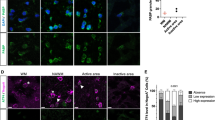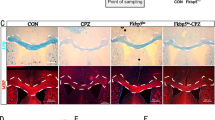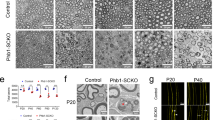Abstract
Myelinating cells, oligodendrocytes in the CNS and Schwann cells in the peripheral nervous system produce an enormous amount of plasma membrane during the myelination process, making them particularly susceptible to disruptions of the secretory pathway. Endoplasmic reticulum stress, initiated by the accumulation of unfolded or misfolded proteins, activates the unfolded protein response, which adapts cells to the stress. If this adaptive response is insufficient, the unfolded protein response activates an apoptotic program to eliminate the affected cells. Recent observations suggest that endoplasmic reticulum stress in myelinating cells is important in the pathogenesis of various disorders of myelin, including Charcot-Marie-Tooth disease, Pelizaeus-Merzbacher disease and Vanishing White Matter Disease, as well as in the most common myelin disorder, multiple sclerosis. A better understanding of endoplasmic reticulum stress in myelinating cells has laid the groundwork for the design of new therapeutic strategies for promoting myelinating cell survival in these disorders.
This is a preview of subscription content, access via your institution
Access options
Subscribe to this journal
Receive 12 print issues and online access
$209.00 per year
only $17.42 per issue
Buy this article
- Purchase on Springer Link
- Instant access to full article PDF
Prices may be subject to local taxes which are calculated during checkout


Similar content being viewed by others
References
Pfeiffer, S.E., Warrington, A.E. & Bansal, R. The oligodendrocyte and its many cellular processes. Trends Cell Biol. 3, 191–197 (1993).
Anitei, M. & Pfeiffer, S.E. Myelin biogenesis: sorting out protein trafficking. Curr. Biol. 16, R418–R421 (2006).
Simons, M. & Trotter, J. Wrapping it up: the cell biology of myelination. Curr. Opin. Neurobiol. 17, 533–540 (2007).
Wrabetz, L. et al. Different intracellular pathomechanisms produce diverse Myelin Protein Zero neuropathies in transgenic mice. J. Neurosci. 26, 2358–2368 (2006).
Pennuto, M. et al. Ablation of the UPR-mediator CHOP restores motor function and reduces demyelination in Charcot-Marie-Tooth 1B mice. Neuron 57, 393–405 (2008). This paper shows that the UPR is involved in the demyelination process in Charcot-Marie-Tooth 1B mice.
Bauer, J. et al. Endoplasmic reticulum stress in PLP-overexpressing transgenic rats: gray matter oligodendrocytes are more vulnerable than white matter oligodendrocytes. J. Neuropathol. Exp. Neurol. 61, 12–22 (2002).
Southwood, C.M., Garbern, J., Jiang, W. & Gow, A. The unfolded protein response modulates disease severity in Pelizaeus-Merzbacher disease. Neuron 36, 585–596 (2002). This paper shows that oligodendrocyte apoptosis in PMD is mediated by the UPR.
van der Voorn, J.P. et al. The unfolded protein response in vanishing white matter disease. J. Neuropathol. Exp. Neurol. 64, 770–775 (2005).
van Kollenburg, B. et al. Glia-specific activation of all pathways of the unfolded protein response in vanishing white matter disease. J. Neuropathol. Exp. Neurol. 65, 707–715 (2006).
Mháille, A.N. et al. Increased expression of endoplasmic reticulum stress-related signaling pathway molecules in multiple sclerosis lesions. J. Neuropathol. Exp. Neurol. 67, 200–211 (2008). This is the first study to show elevated levels of endoplasmic reticulum stress markers in multiple sclerosis demyelinated lesions.
Lees, J.R. & Cross, A.H. A little stress is good: IFN-gamma, demyelination, and multiple sclerosis. J. Clin. Invest. 117, 297–299 (2007).
Kaufman, R.J. Stress signaling from the lumen of the endoplasmic reticulum: coordination of gene transcriptional and translational controls. Genes Dev. 13, 1211–1233 (1999).
Schröder, M. Endoplasmic reticulum stress responses. Cell. Mol. Life Sci. 65, 862–894 (2008).
Ma, Y. & Hendershot, L.M. The unfolding tale of the unfolded protein response. Cell 107, 827–830 (2001).
Rutkowski, D.T. & Kaufman, R.J. A trip to the ER: coping with stress. Trends Cell Biol. 14, 20–28 (2004).
Ron, D. & Walter, P. Signal integration in the endoplasmic reticulum unfolded protein response. Nat. Rev. Mol. Cell Biol. 8, 519–529 (2007).
Ron, D. & Harding, H. PERK and translational control by stress in the endoplasmic reticulum. in Translational Control (eds. Hershey, J., Mathews M., & Sonenberg, N.) 547–560 (Cold Spring Harbor Laboratory Press, Cold Spring Harbor, NY, 2000).
Schröder, M. & Kaufman, R.J. Divergent roles of IRE1alpha and PERK in the unfolded protein response. Curr. Mol. Med. 6, 5–36 (2006).
Harding, H.P., Zhang, Y. & Ron, D. Protein translation and folding are coupled by an endoplasmic-reticulum-resident kinase. Nature 397, 271–274 (1999).
Harding, H.P., Zhang, Y., Bertolotti, A., Zeng, H. & Ron, D. Perk is essential for translational regulation and cell survival during the unfolded protein response. Mol. Cell 5, 897–904 (2000).
Harding, H.P. et al. An integrated stress response regulates amino acid metabolism and resistance to oxidative stress. Mol. Cell 11, 619–633 (2003).
Yoshida, H., Matsui, T., Yamamoto, A., Okada, T. & Mori, K. XBP1 mRNA is induced by ATF6 and spliced by IRE1 in response to ER stress to produce a highly active transcription factor. Cell 107, 881–891 (2001).
Calfon, M. et al. IRE1 couples endoplasmic reticulum load to secretory capacity by processing the XBP-1 mRNA. Nature 415, 92–96 (2002).
Ye, J. et al. ER stress induces cleavage of membrane-bound ATF6 by the same proteases that process SREBPs. Mol. Cell 6, 1355–1364 (2000).
Marciniak, S.J. & Ron, D. Endoplasmic reticulum stress signaling in disease. Physiol. Rev. 86, 1133–1149 (2006).
Szegezdi, E., Logue, S.E., Gorman, A.M. & Samali, A. Mediators of endoplasmic reticulum stress–induced apoptosis. EMBO Rep. 7, 880–885 (2006).
Faitova, J., Krekac, D., Hrstka, R. & Vojtesek, B. Endoplasmic reticulum stress and apoptosis. Cell. Mol. Biol. Lett. 11, 488–505 (2006).
Scheuner, D. & Kaufman, R.J. The unfolded protein response: a pathway that links insulin demand with beta-cell failure and diabetes. Endocr. Rev. 29, 317–333 (2008).
Ji, C. Dissection of endoplasmic reticulum stress signaling in alcoholic and non-alcoholic liver injury. J. Gastroenterol. Hepatol. 23, S16–S24 (2008).
Todd, D.J., Lee, A.H. & Glimcher, L.H. The endoplasmic reticulum stress response in immunity and autoimmunity. Nat. Rev. Immunol. 8, 663–674 (2008).
Skre, H. Genetic and clinical aspects of Charcot-Marie-Tooth's disease. Clin. Genet. 6, 98–118 (1974).
Berger, P., Niemann, A. & Suter, U. Schwann cells and the pathogenesis of inherited motor and sensory neuropathies (Charcot-Marie-Tooth disease). Glia 54, 243–257 (2006).
Oyadomari, S. & Mori, M. Roles of CHOP/GADD153 in endoplasmic reticulum stress. Cell Death Differ. 11, 381–389 (2004).
Marciniak, S.J. et al. CHOP induces death by promoting protein synthesis and oxidation in the stressed endoplasmic reticulum. Genes Dev. 18, 3066–3077 (2004).
Lupski, J.R. & Chance, P.F. Hereditary motor and sensory neuropathies involving altered dosage or mutation of PMP22: the CMT1A duplication and HNPP deletion. in Peripheral Neuropathy (eds. Dyck, P.J. & Thomas, P.K.) 1659–1680 (Elsevier Saunders, Philadelphia, 2005).
Sereda, M.W. & Nave, K.A. Animal models of Charcot-Marie-Tooth disease type 1A. Neuromolecular Med. 8, 205–216 (2006).
Snipes, G.J., Orfali, W., Fraser, A., Dickson, K. & Colby, J. The anatomy and cell biology of peripheral myelin protein-22. Ann. NY Acad. Sci. 883, 143–151 (1999).
Colby, J. et al. PMP22 carrying the trembler or trembler-J mutation is intracellularly retained in myelinating Schwann cells. Neurobiol. Dis. 7, 561–573 (2000).
Dickson, K.M. et al. Association of calnexin with mutant peripheral myelin protein-22 ex vivo: a basis for “gain-of-function” ER diseases. Proc. Natl. Acad. Sci. USA 99, 9852–9857 (2002).
Khajavi, M. et al. Oral curcumin mitigates the clinical and neuropathologic phenotype of the Trembler-J mouse: a potential therapy for inherited neuropathy. Am. J. Hum. Genet. 81, 438–453 (2007). This report demonstrates the therapeutic benefit of facilitated endoplasmic reticulum export in a CMT animal model.
Garbern, J.Y. Pelizaeus-Merzbacher disease: Genetic and cellular pathogenesis. Cell. Mol. Life Sci. 64, 50–65 (2007).
Southwood, C. & Gow, A. Molecular pathways of oligodendrocyte apoptosis revealed by mutations in the proteolipid protein gene. Microsc. Res. Tech. 52, 700–708 (2001).
Gow, A. & Lazzarini, R.A. A cellular mechanism governing the severity of Pelizaeus-Merzbacher disease. Nat. Genet. 13, 422–428 (1996).
Gow, A., Southwood, C.M. & Lazzarini, R.A. Disrupted proteolipid protein trafficking results in oligodendrocyte apoptosis in an animal model of Pelizaeus-Merzbacher disease. J. Cell Biol. 140, 925–934 (1998).
Swanton, E., Holland, A., High, S. & Woodman, P. Disease-associated mutations cause premature oligomerization of myelin proteolipid protein in the endoplasmic reticulum. Proc. Natl. Acad. Sci. USA 102, 4342–4347 (2005).
Dhaunchak, A.S. & Nave, K.A. A common mechanism of PLP/DM20 misfolding causes cysteine-mediated endoplasmic reticulum retention in oligodendrocytes and Pelizaeus-Merzbacher disease. Proc. Natl. Acad. Sci. USA 104, 17813–17818 (2007).
Koeppen, A.H., Barron, K.D., Csiza, C.K. & Greenfield, E.A. Comparative immunocytochemistry of Pelizaeus-Merzbacher disease, the jimpy mouse and the myelin-deficient rat. J. Neurol. Sci. 84, 315–327 (1988).
Roussel, G., Neskovic, N.M., Trifilieff, E., Artault, J.C. & Nussbaum, J.L. Arrest of proteolipid transport through the Golgi apparatus in Jimpy brain. J. Neurocytol. 16, 195–204 (1987).
McLaughlin, M. et al. Genetic background influences UPR, but not PLP, processing in the rumpshaker model of PMD/SPG2. Neurochem. Res. 32, 167–176 (2007).
Schiffmann, R. & Elroy-Stein, O. Childhood ataxia with CNS hypomyelination/vanishing white matter disease—a common leukodystrophy caused by abnormal control of protein synthesis. Mol. Genet. Metab. 88, 7–15 (2006).
Leegwater, P.A. et al. Subunits of the translation initiation factor eIF2B are mutant in leukoencephalopathy with vanishing white matter. Nat. Genet. 29, 383–388 (2001).
Mohammad-Qureshi, S.S., Jennings, M.D. & Pavitt, G.D. Clues to the mechanism of action of eIF2B, the guanine nucleotide exchange factor for translation initiation. Biochem. Soc. Trans. 36, 658–664 (2008).
van der Knaap, M.S., Pronk, J.C. & Scheper, G.C. Vanishing white matter disease. Lancet Neurol. 5, 413–423 (2006).
Wong, K. et al. Foamy cells with oligodendroglial phenotype in childhood ataxia with diffuse central nervous system hypomyelination syndrome. Acta Neuropathol. 100, 635–646 (2000).
Van Haren, K. et al. The life and death of oligodendrocytes in vanishing white matter disease. J. Neuropathol. Exp. Neurol. 63, 618–630 (2004).
Kantor, L. et al. Heightened stress response in primary fibroblasts expressing mutant eIF2B genes from CACH/VWM leukodystrophy patients. Hum. Genet. 118, 99–106 (2005).
Kantor, L. et al. A point mutation in translation initiation factor 2B leads to a continuous hyper stress state in oligodendroglial-derived cells. PLoS ONE 3, e3783 (2008). This paper provides evidence that the UPR adapts oligodendrocytes to eIF2B mutations in Vanishing White Matter Disease.
Frohman, E.M., Racke, M.K. & Raine, C.S. Multiple sclerosis—the plaque and its pathogenesis. N. Engl. J. Med. 354, 942–955 (2006).
Trapp, B.D. & Nave, K.A. Multiple sclerosis: an immune or neurodegenerative disorder? Annu. Rev. Neurosci. 31, 247–269 (2008).
Zhang, K. & Kaufman, R.J. From endoplasmic reticulum stress to the inflammatory response. Nature 454, 455–462 (2008).
Mycko, M.P., Papoian, R., Boschert, U., Raine, C.S. & Selmaj, K.W. Microarray gene expression profiling of chronic active and inactive lesions in multiple sclerosis. Clin. Neurol. Neurosurg. 106, 223–229 (2004).
Cwiklinska, H. et al. Heat shock protein 70 associations with myelin basic protein and proteolipid protein in multiple sclerosis brains. Int. Immunol. 15, 241–249 (2003).
Chakrabarty, A., Danley, M.M. & LeVine, S.M. Immunohistochemical localization of phosphorylated protein kinase R and phosphorylated eukaryotic initiation factor-2 alpha in the central nervous system of SJL mice with experimental allergic encephalomyelitis. J. Neurosci. Res. 76, 822–833 (2004).
Chakrabarty, A., Fleming, K.K., Marquis, J.G. & LeVine, S.M. Quantifying immunohistochemical staining of phospho-eIF2alpha, heme oxygenase-2 and NADPH cytochrome P450 reductase in oligodendrocytes during experimental autoimmune encephalomyelitis. J. Neurosci. Methods 144, 227–234 (2005).
Lin, W. et al. The integrated stress response prevents demyelination by protecting oligodendrocytes against immune-mediated damage. J. Clin. Invest. 117, 448–456 (2007). This paper shows the beneficial effects of the UPR in an immune-mediated demyelinating disease.
Imitola, J., Chitnis, T. & Khoury, S.J. Cytokines in multiple sclerosis: from bench to bedside. Pharmacol. Ther. 106, 163–177 (2005).
Su, Q. et al. Interferons induce tyrosine phosphorylation of the eIF2alpha kinase PKR through activation of Jak1 and Tyk2. EMBO Rep. 8, 265–270 (2007).
Lin, W., Harding, H.P., Ron, D. & Popko, B. Endoplasmic reticulum stress modulates the response of myelinating oligodendrocytes to the immune cytokine interferon-gamma. J. Cell Biol. 169, 603–612 (2005).
Bruck, W., Kuhlmann, T. & Stadelmann, C. Remyelination in multiple sclerosis. J. Neurol. Sci. 206, 181–185 (2003).
Franklin, R.J. Why does remyelination fail in multiple sclerosis? Nat. Rev. Neurosci. 3, 705–714 (2002).
Panitch, H.S., Hirsch, R.L., Schindler, J. & Johnson, K.P. Treatment of multiple sclerosis with gamma interferon: exacerbations associated with activation of the immune system. Neurology 37, 1097–1102 (1987).
Renno, T. et al. Interferon-gamma in progression to chronic demyelination and neurological deficit following acute EAE. Mol. Cell. Neurosci. 12, 376–389 (1998).
Lin, W. et al. Interferon-gamma inhibits central nervous system remyelination through a process modulated by endoplasmic reticulum stress. Brain 129, 1306–1318 (2006). This paper shows that endoplasmic reticulum stress induction in actively remyelinating oligodendrocytes leads to cell death and remyelination failure in an immune-mediated demyelinating diseases.
Corbin, J.G. et al. Targeted CNS expression of interferon-gamma in transgenic mice leads to hypomyelination, reactive gliosis and abnormal cerebellar development. Mol. Cell. Neurosci. 7, 354–370 (1996).
LaFerla, F.M., Sugarman, M.C., Lane, T.E. & Leissring, M.A. Regional hypomyelination and dysplasia in transgenic mice with astrocyte-directed expression of interferon-gamma. J. Mol. Neurosci. 15, 45–59 (2000).
Lin, W. et al. Enhanced integrated stress response promotes myelinating oligodendrocyte survival in response to interferon-gamma. Am. J. Pathol. 173, 1508–1517 (2008).
Boyce, M. & Yuan, J. Cellular response to endoplasmic reticulum stress: a matter of life or death. Cell Death Differ. 13, 363–373 (2006).
Morell, P. & Quarles, R.H. Myelin formation, structure and biochemistry. in Basic Neurochemistry: Molecular, Cellular and Medical Aspects (eds. Siegel, G.J., Agranoff, B.W., Albers, R.W., Fisher, S.K. & Uhler, M.D.) 69–93 (Lippincott-Raven Publishers, Philadelphia, 1999).
Szegezdi, E., Fitzgerald, U. & Samali, A. Caspase-12 and endoplasmic reticulum stress–mediated apoptosis: the story so far. Ann. NY Acad. Sci. 1010, 186–194 (2003).
Nakagawa, T. et al. Caspase-12 mediates endoplasmic reticulum–specific apoptosis and cytotoxicity by amyloid-beta. Nature 403, 98–103 (2000).
Sharma, R. & Gow, A. Minimal role for caspase 12 in the unfolded protein response in oligodendrocytes in vivo. J. Neurochem. 101, 889–897 (2007).
Sharma, R., Jiang, H., Zhong, L., Tseng, J. & Gow, A. Minimal role for activating transcription factor 3 in the oligodendrocyte unfolded protein response in vivo. J. Neurochem. 102, 1703–1712 (2007).
Watkins, T.A., Emery, B., Mulinyawe, S. & Barres, B.A. Distinct stages of myelination regulated by gamma-secretase and astrocytes in a rapidly myelinating CNS coculture system. Neuron 60, 555–569 (2008).
Ozcan, U. et al. Chemical chaperones reduce ER stress and restore glucose homeostasis in a mouse model of type 2 diabetes. Science 313, 1137–1140 (2006).
Takano, K. et al. A dibenzoylmethane derivative protects dopaminergic neurons against both oxidative stress and endoplasmic reticulum stress. Am. J. Physiol. Cell Physiol. 293, C1884–C1894 (2007).
Boyce, M. et al. A selective inhibitor of eIF2alpha dephosphorylation protects cells from ER stress. Science 307, 935–939 (2005). This paper demonstrates the potential of small molecules to protect cells from endoplasmic reticulum stress.
Lindholm, D., Wootz, H. & Korhonen, L. ER stress and neurodegenerative diseases. Cell Death Differ. 13, 385–392 (2006).
Proud, C.G. eIF2 and the control of cell physiology. Semin. Cell Dev. Biol. 16, 3–12 (2005).
Rutkowski, D.T. & Kaufman, R.J. All roads lead to ATF4. Dev. Cell 4, 442–444 (2003).
Novoa, I., Zeng, H., Harding, H.P. & Ron, D. Feedback inhibition of the unfolded protein response by GADD34-mediated dephosphorylation of eIF2alpha. J. Cell Biol. 153, 1011–1022 (2001).
Acknowledgements
We thank D. Douglas for critical comments on the manuscript. W.L. is supported by a National Multiple Sclerosis Society Career Transition Fellowship grant (TA 3026-A-1). B.P. is supported by grants from the US National Institutes of Health (NS34939 and 027336) and the Myelin Repair Foundation.
Author information
Authors and Affiliations
Corresponding authors
Rights and permissions
About this article
Cite this article
Lin, W., Popko, B. Endoplasmic reticulum stress in disorders of myelinating cells. Nat Neurosci 12, 379–385 (2009). https://doi.org/10.1038/nn.2273
Published:
Issue Date:
DOI: https://doi.org/10.1038/nn.2273
This article is cited by
-
Immunomodulatory therapy with glatiramer acetate reduces endoplasmic reticulum stress and mitochondrial dysfunction in experimental autoimmune encephalomyelitis
Scientific Reports (2023)
-
Update on Central Nervous System Effects of HIV in Adolescents and Young Adults
Current HIV/AIDS Reports (2023)
-
Molecular cloning and characterization of endoplasmic reticulum stress related genes grp78 and atf6α from black seabream (Acanthopagrus schlegelii) and their expressions in response to nutritional regulation
Fish Physiology and Biochemistry (2023)
-
Oxalate-induced apoptosis through ERS-ROS–NF-κB signalling pathway in renal tubular epithelial cell
Molecular Medicine (2022)
-
Integrative multiomic analyses of dorsal root ganglia in diabetic neuropathic pain using proteomics, phospho-proteomics, and metabolomics
Scientific Reports (2022)



